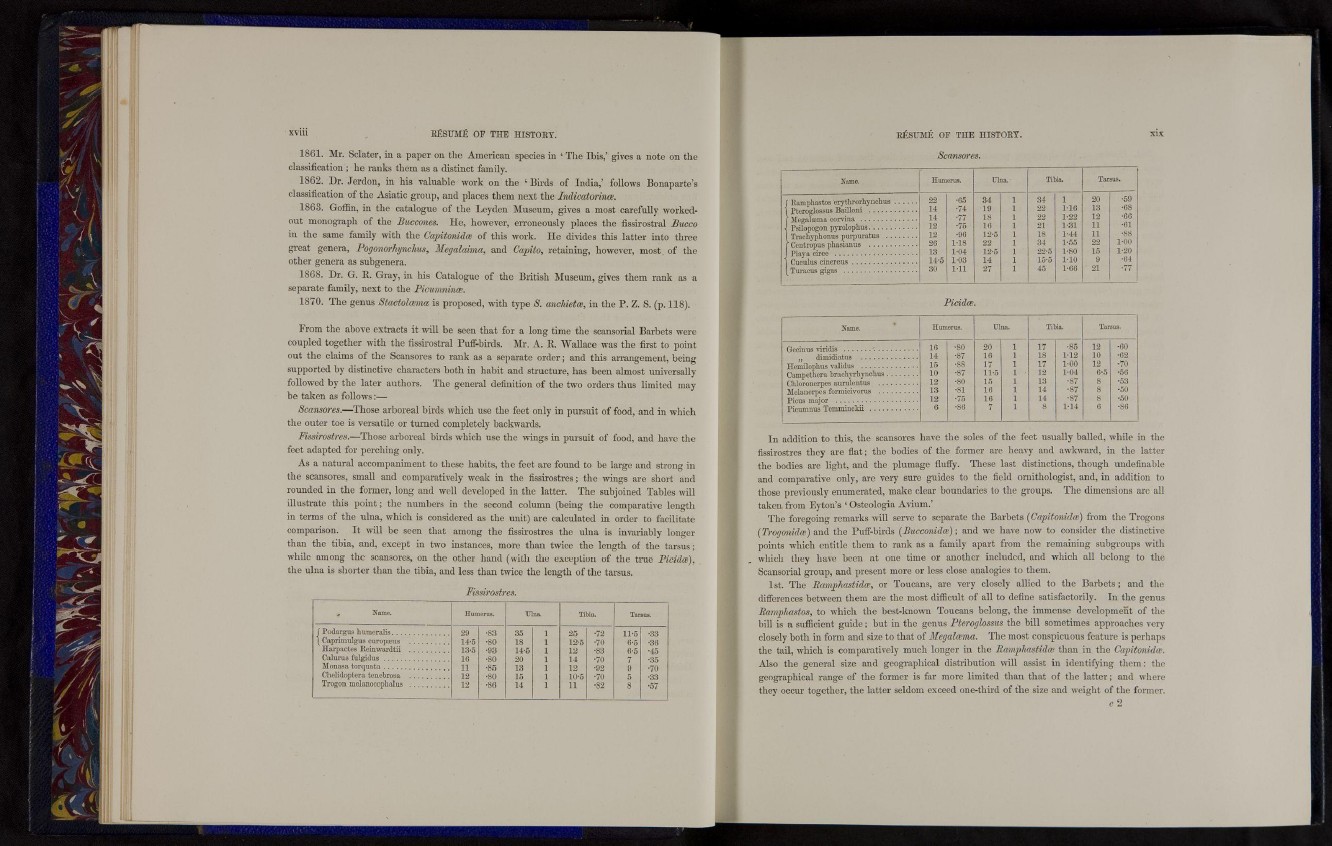
xviii RfiSUME OF THE HISTORY.
1861. Mr. Sclater, in a paper on t h e American species in ' T h e Ibis,' gives a note on t he
classification ; he ranks them as a distinct family.
1862. Dr. Jerdon, in his valuable work on the ' Birds of India,' follows Bonaparte's
classification of t h e Asiatic group, and places t h em next the Indicatorince.
1863. Goffin, in the catalogue of t h e Leyden Museum, gives a most carefully workedout
monograph of the Buccones. He, however, erroneously places the fissirostral Bucco
in the same family with the Capitonidm of this work, lie divides this latter into three
great genera, Pogonorhynchus, Megalaima, and Capito, retaining, however, most, of the
other genera as subgenera.
1868. Dr. G. It. Gray, in his Catalogue of the British Museum, gives them rank as a
separate family, next to t h e Picumnince.
1870. The genus Stactolcema is proposed, with type S. anchietce, in t h e P. Z. S. (p. 118).
From the above extracts it will be seen that for a long time the scansorial Barbets were
coupled together with the fissirostral Puff-birds. Mr. A. It. Wallace was the first to point
out the claims of the Scansores to rank as a separate order; and this arrangement, being
supported by distinctive characters both in habit and structure, has been almost universally
followed by the later authors. The general definition of the two orders thus limited may
be taken as follows:—
Scansores.—Those arboreal birds which use t h e feet only in pursuit of food, and in which
t h e outer toe is versatile or turned completely backwards.
Fissirostres.—Those arboreal birds which use t h e wings in pursuit of food, and have t he
feet adapted for perching only.
As a natural accompaniment to these habits, t h e feet are found to be large and strong in
the scansores, small and comparatively weak in the fissirostres; the wings are short and
rounded in t h e former, long and well developed in t h e latter. The subjoined Tables will
illustrate this point; the numbers in the second column (being the comparative length
in terms of t h e ulna, which is considered as the unit) are calculated in order to facilitate
comparison. It will be seen that among the fissirostres the ulna is invariably longer
than the tibia, and, except in two instances, more than twice the length of the tarsus;
while among the scansores, on the other hand (with the exception of the true Picidw),
t h e ulna is shorter than the tibia, and less than twice t h e length of the tarsus.
Fissirostres.
, Name. Humerus. Ulna. Tibia. Tarsus.
f Podargus humeralis 29 •83 35 1 25 •72 11-5 •33
\ Caprimulgus europoeus 14-5 •80 18 1 12-5 •70
•83
6-5 •36
Harpactes Ileinwardtii .. 13-5 •93 14-5 1 12
6-5 •45
16 •80 20 1 14 •70 7 •35
11 •85 13 1 12 •92 9 •70
Chelidoplera tenebrosa . . .. 12 •80 15 1 10-5 •70 5 •33
12 •86 14 1 11 •82 8 •57
RÉSUMÉ OF THE HISTORY.
Raniphastos erytbrorhynch
Ptcroglossus Bailloni .. ..
Megatema corvina
Psilopogon pyrolophus
Trachyphonus purpuratus
Ccntropus phasianus
Piaya circe
Cuculus cinereus
Turacus gigas
Humerus. ulna. Tibia. Tarsus.
22 •65 34 1 34 1 20 •59
14 •74 19 1 22 1-16 13 •68
14 •77 18 1 22 1-22 12 •66
12 •75 16 1 21 1-31 11 •61
12 •96 12-5 1 18 1-44 11 •88
26 1 4 8 22 1 34 1-55 22 1-00
13 1-04 12-5 1 22-5 1-80 15 1-20
14-5 1-03 14 1 15-5 1-10 9 •64
30 1-11 27 1 45 1-66 21 •77
Picidoe.
Gecinu8 viridis "...
„ dimidiatus
Hemilophus validus
Campctbera brachyrbynchus
Chloronerpes aurulcntus ..
Melanerpes formicivorus ..
Picus major
Picumuus Temminckii . . ..
20
16
17
11-5
15
16
16
/
•85
1-12
1-00
1-04
•87
•87
•87
1-14
I n addition to this, the scansores have the soles of the feet usually balled, while in the
fissirostres they are flat; the bodies of the former arc heavy and awkward, in the latter
t h e bodies are light, and the plumage fluffy. These last distinctions, though undefinable
and comparative only, are very sure guides to the field ornithologist, and, in addition to
those previously enumerated, make clear boundaries to the groups. The dimensions arc all
taken from Eyton's ' Osteología Avium.'
The foregoing remarks will serve to separate t h e Barbets (Capitonidce) from the Trogons
(Trogo?u'da') and the Puff-birds (Bucconida>); and we have now to consider the distinctive
points which entitle them to rank as a family apart from the remaining subgroups with
which they have been at one time or another included, and which all belong to the
Scansorial group, and present more or less close analogies t o them.
1st. The Bamphastida', or Toucans, are very closely allied to the Barbets; and the
differences between them are the most difficult of all to define satisfactorily. In the genus
Bamphastos, to which the best-known Toucans belong, the immense development of the
bill is a sufficient guide; but in the genus Ptcroglossus the bill sometimes approaches very
closely both in form and size to that of Mcgala'ma. The most conspicuous feature is perhaps
the tail, which is comparatively much longer in the Bamphastida' than in t h e Capitonida>.
Also the general size and geographical distribution will assist in identifying them: the
geographical range of the former is far more limited than that of the l a t t e r ; and where
they occur together, the latter seldom exceed one-third of t h e size and weight of the former.
c 2